#The Campi Flegrei Archaeological Park
Explore tagged Tumblr posts
Text

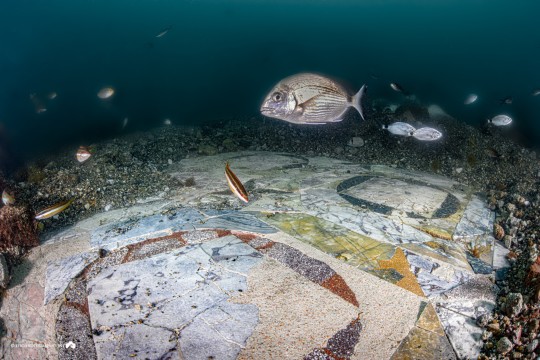
Archaeologists Discover Ancient Roman Mosaic in Sea off Italy
Researchers studying an underwater city in Italy say they have found an ancient mosaic floor that was once the base of a Roman villa, a discovery that the local mayor called "stupendous."
The discovery was made in Bay Sommersa, a marine-protected area and UNESCO World Heritage Site off the northern coast of the Gulf of Naples. The area was once the Roman city of Baia, but it has become submerged over the centuries thanks to volcanic activity in the area. The underwater structures remain somewhat intact, allowing researchers to make discoveries like the mosaic floor
The Campi Flegrei Archaeological Park announced the latest discovery, which includes "thousands of marble slabs" in "hundreds of different shapes," on social media.
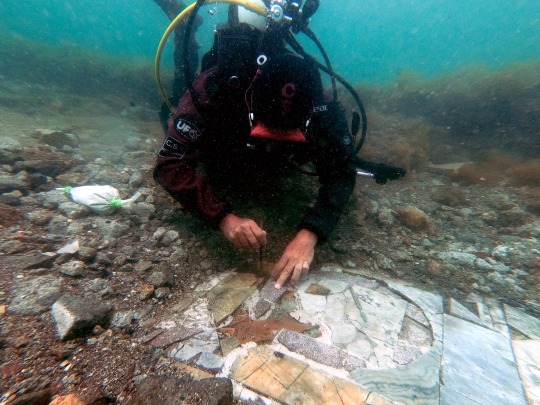
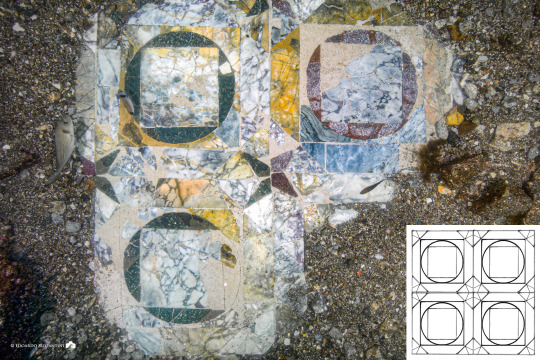
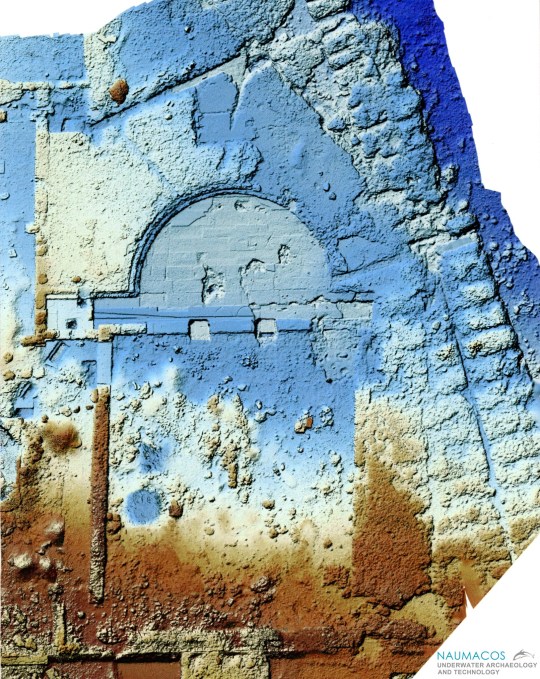
"This marble floor has been at the center of the largest underwater restoration work," the park said, calling the research "a new challenge" and made "very complicated due to the extreme fragment of the remains and their large expansion."
The marble floor is made of recovered, second-hand marble that had previously been used to decorate other floors or walls, the park said. Each piece of marble was sharpened into a square and inscribed with circles. The floor is likely from the third century A.D., the park said in another post, citing the style of the room and the repurposing of the materials as practices that were common during that time.
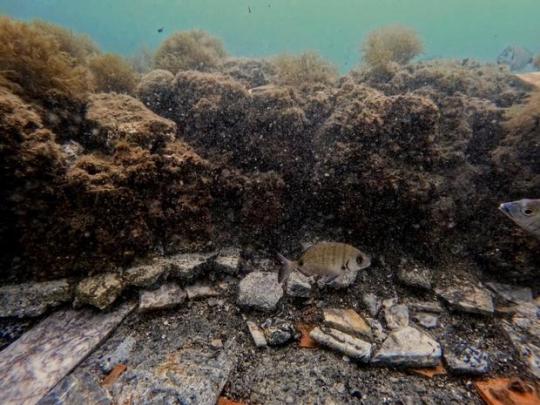

Researchers are working carefully to extract the marble pieces from the site, the park said. The recovery work will require careful digging around collapsed walls and other fragmented slabs, but researchers hope to "be able to save some of the geometries."
Once recovered, the slabs are being brought to land and cleaned in freshwater tanks. The marble pieces are then being studied "slab by slab" to try to recreate the former mosaic, the park said.
"The work is still long and complex, but we are sure that it will offer many prompts and great satisfactions," the park said.
By Kerry Breen
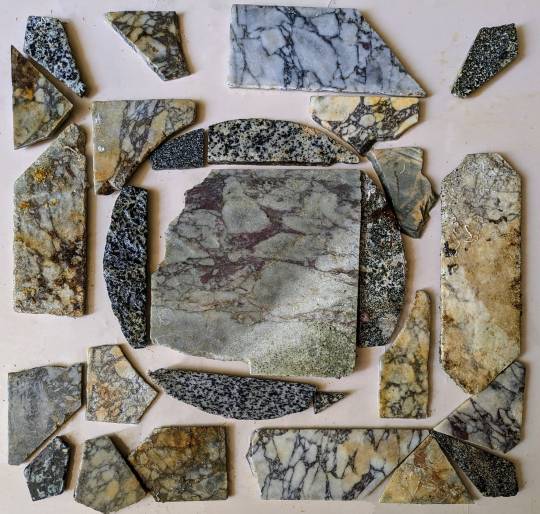
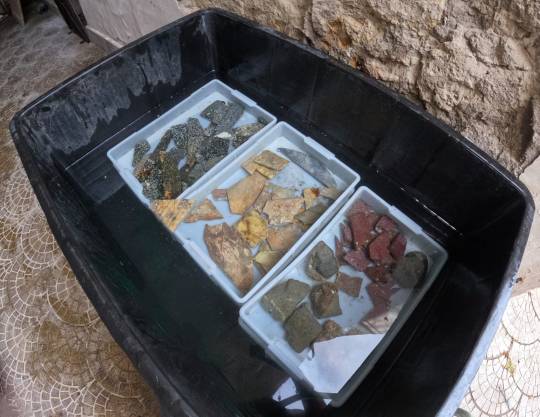
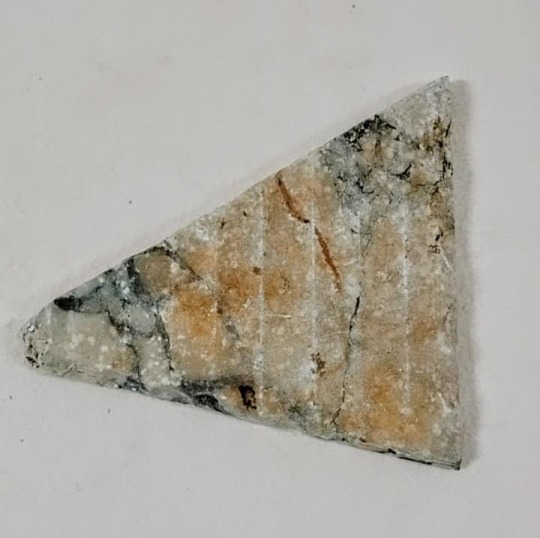
#Archaeologists Discover Ancient Roman Mosaic in Sea off Italy#Bay Sommersa#Roman city of Baia#The Campi Flegrei Archaeological Park#mosaic#ancient mosaic#ancient artifacts#archeology#archeolgst#history#history news#ancient history#ancient culture#ancient civilizations#roman history#roman empire#roman art#ancient art
301 notes
·
View notes
Text

A stunning floor mosaic that once adorned an ancient Roman villa has been unearthed underwater near Naples, Italy. The colorful marble would have made up a late Roman-era porch, or “protiro,” at the building’s entrance, according to a statement from the Campi Flegrei Archaeological Park. Researchers think the discovery dates to the third century C.E. Photograph; Fish swim by an ancient Roman mosaic once part of a wealthy villa in the city of Baiae. Edoardo Ruspantini / Campi Flegrei Archaeological Park : Article Smithsonian Magazine
8 notes
·
View notes
Text
A stunning underwater mosaic from the late Roman Empire has been discovered in the Bay of Naples, near the resort town of Baiae.🌊🎨
The mosaic, likely from a villa owned by the Roman patrician class, was lost due to bradyseism, a seismic phenomenon that caused the land to sink. Archaeologists are restoring and studying the mosaic tiles, which were found scattered on the sea floor.
( 📸 by Archaeological Park Campi Flegrei)



#historiy #italy #art #discover #roman #pubitynews
0 notes
Text
Painted tomb discovered in Cumae (Italy)—a banquet frozen in time

At the foot of the hill on which sits the ancient city of Cumae, in the region of Naples, Priscilla Munzi, CNRS researcher at the Jean Bérard Centre (CNRS-EFR), and Jean-Pierre Brun, professor at the Collège de France, are exploring a Roman-era necropolis. They now reveal the latest discovery to surface in the archaeological dig they have led since 2001: a painted tomb from the second century B.C. In excellent condition, the tomb depicts a banquet scene, fixed by pigments.
Twice the size of Pompeii, the ancient city of Cumae is located 25 km west of Naples on the Tyrrhenian Sea facing the island of Ischia, at the Campi Flegrei Archaeological Park. Ancient historians considered Cumae the oldest Ancient Greek settlement in the western world. Founded in the latter half of the 8th century B.C. by Greeks from Euboea, the settlement grew quickly and prospered over time.
In recent years, French researchers have focused on an area where a Greek sanctuary, roads and a necropolis were found. Read more.
254 notes
·
View notes
Photo

Parco Archeologico Sommerso di Baia. "From commercial port to protected marine area" To trace the main stages of the long journey that led to the establishment of the park, it is first necessary to explain why this area is below sea level today. We are at Campi Flegrei (from Greek burning earth). In this area of volcanic origin, there is a phenomenon of bradysis consisting of a relatively slow increase in the human time scale, but very rapid compared to geological times (positive bradysis) or a descent of ground level (negative bradysis). Sometimes, as in the Phlegraean Fields, these movements can repeat themselves cyclically over the centuries. Usually, this phenomenon is caused by changes in the volume of a near-surface magma chamber that empties and fills. temperature changes that affect the volume of water in very porous subsoil. Due to the phenomenon of bradyism, the ancient coastline was submerged in a flood, as a result of which all the buildings built there were flooded. Pozzuoli, the most important commercial city, Baia the most famous settlement, and Miseno, the center of the military navy, flooded places of great importance in the Roman period. The expansion of the harbor quay brought sculptures and architectural structures to light. elements, imperial stamped aquarium fistulas. #unesco #history #archaeology #archaeologist #ancient #archeologia #travel #ancientcity #discovery #follow #archeological #instalikes #instagood #amazing #likes #nice #photooftheday #travelingram #tourism #travelgram #instagram #bestoftheday #photoohistory #NYC #usa #археология #amazingplace #igersitalia #viagg #newyork# (Parco Archeologico Sommerso di Baia) https://www.instagram.com/p/CU0EHzfM4O1/?utm_medium=tumblr
#unesco#history#archaeology#archaeologist#ancient#archeologia#travel#ancientcity#discovery#follow#archeological#instalikes#instagood#amazing#likes#nice#photooftheday#travelingram#tourism#travelgram#instagram#bestoftheday#photoohistory#nyc#usa#археология#amazingplace#igersitalia#viagg#newyork
0 notes
Photo

🇮🇹Oggi pausa pranzo in una delle migliori pizzerie di Napoli! 🍕 🎥E' stata una giornata di lavoro molto intensa: stiamo preparando per voi dei video che entreranno a far parte del nostro canale YouTube NGT-IT. 🎉 ✨Vi guideremo nei luoghi più preziosi e nascosti di tutta la Campania: dai grandi parchi archeologici di Pompei, Ercolano e Paestum, alle gemme incastonate tra le strette strade del centro storico di Napoli, alla maestosa Reggia di Caserta, i meravigliosi Campi Flegrei... Tutto sarà sempre accompagnato dal fascino della storia e dalle bellezze naturali! 🌿 🕚Ci vediamo... Presto! 🔜#staytuned • 🇬🇧Today lunch break in one of the best pizzerias in Naples! 🍕 @pizzeriadamichele 🎥It's been a very busy day of hard work: we are preparing for you videos that will become part of our NGT-IT YouTube channel. 🎉 ✨We will guide you to the most precious and hidden places of all Campania: from the great archaeological parks of Pompeii, Herculaneum and Paestum, to the gems nestled in the narrow streets of the historical center of Naples, to the majestic Palace of Caserta, the wonderful Phlaegrean Fields... Everything will always be accompanied by the charm of history and natural beauty! 🌿 🕚See you... Soon! 🔜#staytuned (presso Naples, Italy) https://www.instagram.com/p/CA-2I7jKzhk/?igshid=1u9mx7558like
0 notes
Link
Pozzuoli is an Italian city from Roman times on the coast of Campania.
The name comes from the Latin word Puteoli, with the root word ‘puteus’, meaning 'well’ and 'osco fistulus’, meaning cave. This place is well known for its well-preserved Roman amphitheater, baths, a necropolis, with stuccoed and painted underground chambers and a plaza that rises and falls with volcanic activity. It is also a UNESCO World Heritage Site because of the geological process called “bradyseism” and it is the hometown of the world-renowned film diva, Sofia Loren. Here are the best things to do in Pozzuoli, Italy!
[toc]
1. Rione Terra: The old part of Pozzuoli (from 19.14 USD)
This is one of the most interesting and historically important sites in Italy. Rione Terra reflects the ancient part of Pozzuoli and includes untouched old streets, buildings, and existing houses, which have not changed for hundreds of years. It also includes the old port area and the old church.
You will never regret a tour of this area, as there is an English tour guide who is very informative and explains everything. It also includes a film presentation. The underground sections of the city are open on a limited basis, only twice a week, on Saturdays and Sundays.
2. The Flavian Amphitheater (from 119.65 USD)
This is the third-largest Roman amphitheater in Italy, after the Colosseum in Rome and the Campanian Amphitheater of Santa Maria Capua Vetere. With a seating capacity of 20,000, this was the well-known site of gladiator fights, chariot races, fights with wild beasts, animal slaying and even executions - imagine how people used to witness these events.
Even after many centuries, the structure is still intact and well-preserved. The Flavian Amphitheater is open Wednesday to Monday, from 9 am to an hour before sunset, so visitors may check out the schedule and arrange a tour guide that speaks English.
3. The Macellum (Temple of Serapide) (from 77.77 USD)
This is a Roman marketplace built in the 1st century AD. When excavations of this site began, archaeologists found a statue of the Egyptian God Serapis, which is why it is also called the Temple of Serapide.
The Macellum, which means the market building of the Roman colony of Puteoli, would have been two stories high and surrounded by an arcade of granite columns.
The ground beneath the columns actually moves up and down because of a phenomenon known as “bradyseism”. This means that sometimes the columns can be standing in a few centimeters of water or none at all.
This is why is also called it the “Sunken Temple of Serapide”. The site is not really open to the public since the area is fenced off but visitors can view it from street level, looking down.
4. Vulcano Solfatara
The Solfatara Volcano still exhibits a remarkable amount of activity that includes sulfurous steam and small eruptions of hot mud and sand. Solfatara once operated as a mine for alum, sulfur, and kaolin.
It was around the year 1900 that a thermal bath was built here and people began to enjoy the health benefits of the volcano’s mud and sulfurous water, as well as steam baths in the so-called “Stufe”.
As of today, this place is open for public viewing and there is a day and evening tour, which everyone can enjoy. It takes around 45 minutes to walk through the whole area where guests can learn about and witness the Fangaia (mud pit), the Bocca Grande, the Pozzo, the Stufe and some natural, geological, botanical and wildlife wonders.
There is a playground here for kids to enjoy and there is also a bar that serves coffee and ice cream and sells souvenirs and postcards, as well as tickets for the bus and subway. There is also a bookshop here that offers a wide array of products for the face and body, collections of minerals, fossils and more.
And, lastly, there is a campsite here that is open all year round and offers free amenities and services like a pool, hot shower, and electricity.
5. Lago d'adverno (Lake Avernus)
As the story goes, this is the gateway to Hell as per the Cumaean Sibyl’s predictions, when Aeneas came here to ask her how he could travel to Hades and speak with his dead father (from the book VI Aeneid).
But this 100 foot (30.5 meters) deep lake, with no natural outlet, was surrounded by dense forest in ancient times. During the Roman Empire, they converted the lake into a naval harbor called Portus Julius, which was linked to the sea by a canal via the Lago di Lucrino and to Cumae by a tunnel, which was the world’s first major road tunnel.
World War II destroyed part of it and the tunnel was closed since it was too unstable and also damaged by earthquakes.
Nowadays, people can enjoy walking, jogging, biking or just sitting on the green grass and watching the beauty of the lake here. If you are traveling here, there are lots of cafes and restaurants nearby that have a good view of the lake.
6. Cumae (from 191.43 USD)
Cumae is an ancient city of Magna Graecia on the Tyrrhenian coast. Founded by settlers from Euboea in the 8th century BC, it is about 19.3 km (12 miles) from Naples and probably the oldest Greek mainland colony. It was said to be the home of Sibyl, the Greek prophetess, whose cavern still exists.
Today this ancient city is still preserved in some parts and from above, it offers a great view of the sea, dunes, forest, and other tourist spots, nearby.
7. Underwater Archaeological Park in Baia
They say that Baia catered to the recreational whims of the rich and powerful among the Roman elite. During the 8th century, the city was sacked by the Saracens and it was abandoned in 1500.
Since the city remained empty, the water level slowly rose due to volcanic vents and most of the ancient ruins were drowned under the shallow waters of the bay.
Now the Underwater Archaeological Park in Baia can be visited by scuba diving, snorkeling, and a glass-bottomed boat tour. It is a large area in the Bay of Naples and the islands offer seven dive sites that feature all different kinds of ruins from the sunken city.
8. Sibyl's Cave (77.77 USD)
As per the old poem and myth, the Sybil acts as a kind of guide to the underworld, into which Aeneas must descend to seek the advice of his dead father Anchises and fulfill his destiny.
The passage to this cave has many entrances and is 5 meters (16.4 feet) high by 131 meters (429.8 feet) long, with several side galleries and cisterns. It can fit a large chariot and during Roman times, the cave was a tunnel that linked to Lake Avernus, which was a naval harbor, making this the world’s first major road tunnel.
9. Oasi Naturalistica di Monte Nuovo (from 775.31 USD)
Monte Nuovo is a volcano that is part of Campi Flegrei. It is located in the town of Pozzuoli, near Lake Lucrino and its formation was famous because of an eruption that occurred in 1538, which destroyed the medieval village of Tripergole and caused the whole community to go up in flames.
Because of that eruption, all vegetation was destroyed and in its place remained two dry craters.
After this unforgettable eruption, the volcano and its crater became home to different kinds of flora and fauna and, in 1996, the entire area was declared a naturalistic oasis. From this point on people have come here to climb to the top of the crater for the breathtaking views.
10. Cathedral Basilica San Procolo Martire
This is the oldest and main place of Catholic worship in Pozzuoli. The church was originally made of cells, square in shape and was built with white marble blocks, connected to each other, but it was seriously damaged when the town of Tripergole was devastated.
It was rebuilt and then experienced a fire, then rebuilt again but the old marble blocks are still intact.
Now, this cathedral still stands to tell the history of the old empire and serves its people with its beauty and architectural design. Everyone can see the courtyard through its transparent floors and its designs are really fascinating to all.
More ideals for you: Top 10 things to do in Port Said
From : https://wikitopx.com/travel/top-10-things-to-do-in-pozzuoli-709552.html
0 notes
Text
Painted tomb discovered in Cumae (Italy): A banquet frozen in time
Painted tomb discovered in Cumae (Italy): A banquet frozen in time
September 29, 2018 by Ancientfoods
Original article:
Popular archaeology
CNRS—At the foot of the hill on which sits the ancient city of Cumae, in the region of Naples, Priscilla Munzi, CNRS researcher at the Jean Bérard Centre (CNRS-EFR), and Jean-Pierre Brun, professor at the Collège de France, are exploring a Roman-era necropolis. They now reveal the latest discovery to surface in the archaeological dig they have led since 2001: a painted tomb from the 2nd century B.C. In excellent condition, the tomb depicts a banquet scene, fixed by pigments.
Twice the size of Pompeii, the ancient city of Cumae is located 25 km west of Naples on the Tyrrhenian Sea facing the island of Ischia, at the Campi Flegrei Archaeological Park. Ancient historians considered Cumae the oldest Ancient Greek settlement in the western world. Founded in the latter half of the 8th century B.C. by Greeks from Euboea, the settlement grew quickly and prospered over time.
In recent years, French researchers have focused on an area where a Greek sanctuary, roads and a necropolis were found. Among the hundreds of ancient sepulchers unearthed since 2001, they have discovered a series of vaulted burial chambers made of tuff, a volcanic stone found in the area. People entered the tomb through a door in the façade sealed with a large stone block. The space inside was generally composed of a chamber with three vaults or funerary beds. The tombs were raided in the 19th century, but recovered remains and traces of funerary furnishings, which archaeologists have used to date the tombs to the second century B.C., indicate the high social status of those buried within.
Until now, only tombs painted red or white had been found, but in June 2018 researchers discovered a room with exceptionally executed figure painting. A naked servant carrying a jug of wine and a vase is still visible; the banquet’s guests are thought to have been painted on the side walls. Other elements of the banquet can also be distinguished. In addition to the excellent state of conservation of the remaining plaster and pigments, such a décor in a tomb built in that period is rare; its “unfashionable” subject matter was in vogue one or two centuries earlier. This discovery is also an opportunity to trace artistic activity over time at the site.
To preserve the fresco, archaeologists removed it, along with fragments found on the ground, in order to re-assemble the décor like a puzzle.
The digs were carried out with financial support from the French Ministry of Europe and Foreign Affairs, the Ecole française de Rome and the Fondation du Collège de France. This research is part of a concession granted by the Italian Ministry of Cultural Assets and Activities in partnership with the Phlegraen Fields archaeological site.
Advertisements
Share this:
Like this:
Like Loading…
Related
Posted in Europe, Uncategorized | Tagged archaeology, Europe, Roman, Wine | Leave a Comment
Source: https://bloghyped.com/painted-tomb-discovered-in-cumae-italy-a-banquet-frozen-in-time/
0 notes